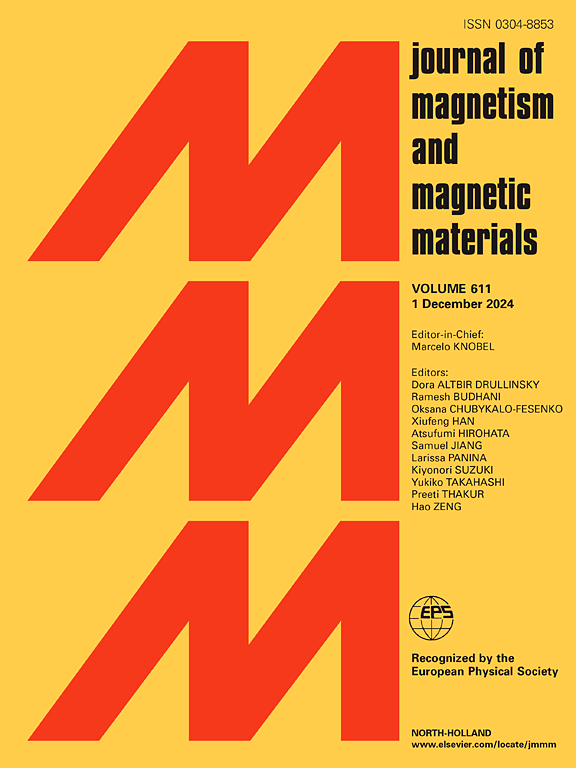具有高居里温度和载流子迁移率的二维铁磁性五极fep2
IF 2.5
3区 材料科学
Q3 MATERIALS SCIENCE, MULTIDISCIPLINARY
引用次数: 0
摘要
在这项研究中,我们通过密度泛函理论(DFT)计算研究了二维五边形磷化铁(penta-FeP2)的稳定性、电子结构和磁性能。预测的 penta-FeP2 是一种调频半导体,具有热稳定性、动态稳定性和机械稳定性,直接带隙为 0.916 eV。估计的热稳定性超过了 705 K,远远高于室温。MAE 高达 358 μeV/Fe,这增强了五碲铁铂的调频稳定性。此外,这种二维材料还表现出超高的空穴和电子迁移率。光电子迁移率高达 21,992 cm2 V-1 s-1,而光空穴迁移率为 2,890 cm2 V-1 s-1。它还表现出各向同性的可见光吸收和室温下 ∼20 W m-1 K-1 的低晶格热导率。二维 FeP2 具有许多理想的特性,包括出色的稳定性、高透明度、大 MAE、高载流子迁移率和直接带隙。这些特性使其成为自旋电子器件的理想候选材料。本文章由计算机程序翻译,如有差异,请以英文原文为准。
Two-dimensional ferromagnetic penta-FeP2 with high Curie temperature and carrier mobility
In this work, we investigated the stability, electronic structures, and magnetic properties of a 2D pentagonal iron phosphide (penta-FeP2) through density functional theory (DFT) calculations. The predicted penta-FeP2 is an FM semiconductor with thermal, dynamical, and mechanical stability, and narrow direct band gap of 0.916 eV. The estimated TC surpasses 705 K, which is sufficiently higher than room temperature. The MAE is as high as 358 μeV/Fe, which enhances the FM stability of the penta-FeP2. In addition, the 2D material also exhibits ultrahigh mobility for both holes and electrons. The light electron mobility is up to 21, 992 cm2 V−1 s−1, while the light hole mobility is 2, 890 cm2 V−1 s−1. It also exhibits isotropic visible light absorption and a low lattice thermal conductivity of ∼20 W m−1 K−1 at room temperature. The 2D FeP2 displays a number of desirable properties, including excellent stability, high TC, large MAE, high carrier mobility, and a direct band gap. These characteristics make it a promising candidate for spintronic devices.
求助全文
通过发布文献求助,成功后即可免费获取论文全文。
去求助
来源期刊

Journal of Magnetism and Magnetic Materials
物理-材料科学:综合
CiteScore
5.30
自引率
11.10%
发文量
1149
审稿时长
59 days
期刊介绍:
The Journal of Magnetism and Magnetic Materials provides an important forum for the disclosure and discussion of original contributions covering the whole spectrum of topics, from basic magnetism to the technology and applications of magnetic materials. The journal encourages greater interaction between the basic and applied sub-disciplines of magnetism with comprehensive review articles, in addition to full-length contributions. In addition, other categories of contributions are welcome, including Critical Focused issues, Current Perspectives and Outreach to the General Public.
Main Categories:
Full-length articles:
Technically original research documents that report results of value to the communities that comprise the journal audience. The link between chemical, structural and microstructural properties on the one hand and magnetic properties on the other hand are encouraged.
In addition to general topics covering all areas of magnetism and magnetic materials, the full-length articles also include three sub-sections, focusing on Nanomagnetism, Spintronics and Applications.
The sub-section on Nanomagnetism contains articles on magnetic nanoparticles, nanowires, thin films, 2D materials and other nanoscale magnetic materials and their applications.
The sub-section on Spintronics contains articles on magnetoresistance, magnetoimpedance, magneto-optical phenomena, Micro-Electro-Mechanical Systems (MEMS), and other topics related to spin current control and magneto-transport phenomena. The sub-section on Applications display papers that focus on applications of magnetic materials. The applications need to show a connection to magnetism.
Review articles:
Review articles organize, clarify, and summarize existing major works in the areas covered by the Journal and provide comprehensive citations to the full spectrum of relevant literature.
 求助内容:
求助内容: 应助结果提醒方式:
应助结果提醒方式:


